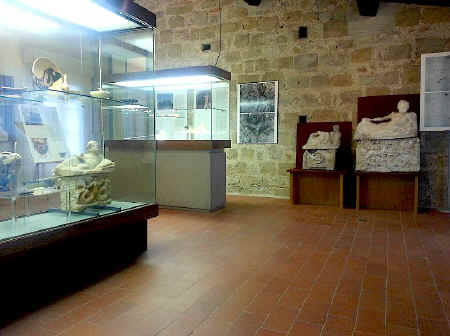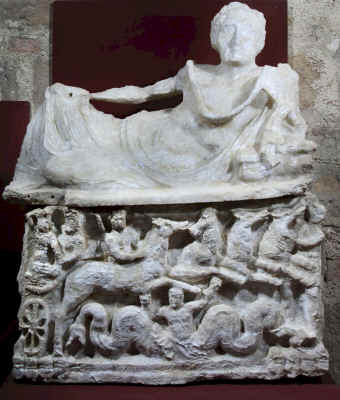L'
Antiquarium di Sant’Appiano
The
Antiquarium of Sant’Appiano is a small archaeological museum located in rooms
adjoining the Pieve di Sant’Appiano just a few km from Barberino Val
d’Elsa. It houses some of the material found during archaeological digs in
the surrounding area following the first accidental discoveries at the beginning
of the 20 C.

Some Etruscan chamber tombs were found during farm work in the fields between
1907 and 1910 and, although robbed long before, provided a large number of finds
covering a long period from the 8th to the 2nd centuries B.C. Many of the finds
are of extremely fine artistic quality and include not only local work but also
imports, as evidenced by the numerous red and black figure Attic vases, dating
from around the 6th to the 4th centuries B.C. and the alabaster funerary urns of
Hellenistic age in the style of Volterra,
illustrating Greek myths. The variety in the objects is due above all to the
site's privileged position from a commercial point of view, as it stood on the
crossroads of several main roads that, already important in Etruscan and Roman
times, became even more so during the Middle Ages, when the route along the Val
d'Elsa (Elsa Valley) also coincided with the via
Francigena.
The archaeological discoveries dating from the 1st century B.C. and later are
decidedly inferior in number and quality, showing that there was a fall in the
population and a regression of the cultural life in the entire area during the
Roman Imperial Age. This phenomenon can be linked to the decline of the nearby
Etruscan town of Volterra, which was not replaced by an equally flourishing
Roman colony.

The
Museum
A
door in the right hand aisle leads into the 13 C cloisters built
with square pilasters and Ionic type columns. Another door opened off
from here into the Chapter house, topped with a two-coloured arch and a
three light window with setback arches (now bricked up) beside it. The
canons' house is built around the cloisters and hosts the small
antiquarium museum in two rooms on the first floor.
The first room of the museum is dedicated mainly to objects found in the
excavations at San Martino ai Colli, to the South of the church
buildings, where two tombs belonging to noble families were found. The
large amount and variety of material brought to light leads us to
believe that a small necropolis once stood here and that, over the
centuries, tombs from various periods had ended up one on top of the
other and in communication.
The group of Hellenistic cinerary urns in alabaster is particularly
interesting. There is a medium-sized urn reproducing the Rape of
Proserpine on the casing placed against the right hand wall. The same
subject is also shown on one of the casings on the wall opposite the
entrance, though here the marine demon is shown with two tails and
placed in the centre. The cover is decorated with a recumbent virile
figure placed in the usual position; the narrow sides bear a winged male
demon, while the typical lion's paws are still visible at the bottom.
The next urn is more simply decorated with a central rosette between two
palmettes set inside a frame with a smooth surface; the married couple
that adorns the cover, one of whom is minus its head, are shown partly
lying down. Three other covers with recumbent male and female figures
are arrayed along the walls. Two more cinerary urns are displayed in the
first glass case on the left of the entrance. The first is quite small
and bears the figure of a winged marine monster on the front. The second
is much larger, but without a cover, and shows a horseman, wrapped in
the winding sheet and about to enter Hades.
The display case also contains some plain unglazed ceramics for everyday
use, others with the typical black varnish from the Volterra area, and
red figure Attic ceramics datable from around the 6th and 5th centuries
B.C., which were imported from the coastal towns, in particular
Populonia, and whose presence denotes well developed commerce and a
fairly advanced economic and cultural level. The shelf above hosts part
of a black varnished kylix with red figures dating from the early 4th
century B.C., though only the bowl has survived, recomposed and
reintegrated where pieces are missing. The internal tondo shows the
scene of a conversation between a standing male nude and a seated woman,
wrapped in a mantle and with a cornucopia in her hands, perhaps a Satyr
and a Bacchante. The other partially composed vase is a Kelebe,
attributed to the workshop of the painter of Hesione, active in Volterra
in the second half of the 4th century B.C.
The second glass case contains various examples of material found in the
area of what is today Petrognano, the site of the castle of Semifonte in
the 12 C, built, according to documentary evidence, in around
1180. It did not survive long as its excellent geographical position and
fast growing development soon attracted the attention of Florence,
which, after besieging it for two years, forced it to surrender in 1202
and then razed it to the ground.
A group of broken Etruscan-Roman ceramics show that there must have been
a settlement on this site long before the castrum. In addition, numerous
shards dating from a later period (15 C and 16 C) were
discovered in the immediate vicinity and thus prove that the area was
inhabited even after Semifonte had been destroyed, in spite of the fact
that the City Council of Florence had categorically forbidden any new
building on the site of the old castle. This interdiction was probably
limited to the original area of the castle, so that some small groups of
houses were spared from demolition. After many alterations and
adaptations, they appear to have survived to this day, at least judging
from the buildings that now make up Petrognano.
The second room contains objects discovered during the
excavations of the two Etruscan tombs discovered on a farm called
Piazza, near Sant'Appiano, in 1973. On the immediate right of the
entrance, there is a series of half-spherical "loaf" type
inscribed pillars in sandstone and a rather fragmentary funerary urn,
small, square-shaped and roughly carved. The same group also includes
the small column-like cippus, shaped like a reversed truncated cone and
fitted onto a stone base, placed in a corner on the opposite side of the
room. The only really ancient materials that were certainly tomb
furnishings are the minute shards of black-varnished ceramics, roughly
datable from the Hellenistic period, on display in the glass case on the
right. The excavations also brought a large quantity of late mediaeval
and Renaissance ceramics (dishes, bowls, basins, coolers, oil jars) to
light, dating from when the tombs were put to use again, first for
storage and later for dumping rubbish in the 15 C to the 16 C.
A copy of a capital from the old Baptistery, decorated with symbolic
emblems sculpted in high relief, stands on a cylindrical support in one
corner of the room. The hybrid creature with the head and wings of a
predatory bird, the body of a lion and the tail of a snake represents
the virtues of Knowledge, Fortitude and Prudence; the cross moline
recalls the Mystery of the Salvation; while the snake represents the
plan of a city enclosed within a schematised ring of towers and walls, a
symbol of the Celestial City. Beside it we can see the small pagan idol
of the god Eros astride an animal that was discovered when the
Baptistery was demolished in 1805, after being seriously damaged by an
earthquake.
|